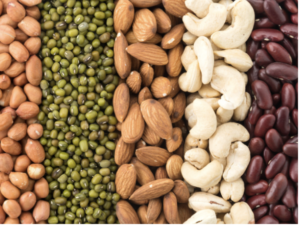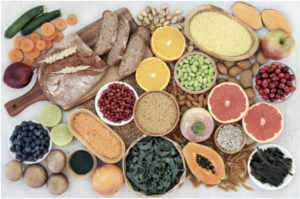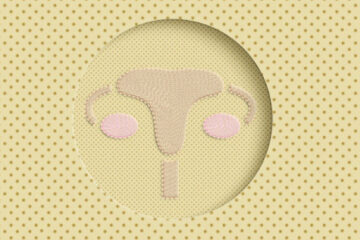You may have heard the term fibre before and wondered, what exactly is it?
Dietary fibre is a type of carbohydrate that comes from plant foods such as wholegrains, beans, pulses, vegetables, fruit, nuts and seeds. It cannot be digested or absorbed by the body, so it passes through the stomach and intestines before moving out of the body.

Dietary fibre has a very important role to play in our overall health. To explain this, it helps to understand that often fibre can be classed into two different types.
Soluble fibre, which dissolves in water and forms a gel-like substance. Soluble fibre can help reduce blood sugar levels and improve cholesterol levels.
Good sources of soluble fibre include citrus fruits, avocados, beans and lentils, peas and oats.
The other main type of fibre is insoluble fibre, which helps move food along digestive system and increases bulk of stool. This is particularly important for those who experience constipation. Good sources of insoluble fibre include wholewheat flour, potatoes, vegetables, nuts and beans.
It’s best to aim for a wide variety of fibre rich sources of foods in your diet for optimal benefits.
Check the food labels to know what a good source of fibre is when you are next shopping.
A high fibre food will contain >6g fibre per 100g, but anything with 3g or more fibre per 100g is a source of fibre.
What are the benefits of eating more fibre?
There are many benefits associated with a diet high in dietary fibre. Some of these include:
- Makes you feel fuller
- Lowering risk of bowel related issues – a good intake of dietary fibre can help solidify, soften and bulk stool, making it easier to pass. This is important if you suffer from constipation or diarrhoea.
- Lowering cholesterol levels – in particular, soluble fibre can reduce low-density lipoprotein cholesterol levels. There is also some research into fibre improving blood pressure levels.
- Reducing risk of dying from certain cancers such as bowel cancer, as well as reduces chances of developing cardiovascular disease.
- Controlling blood sugar – this is particularly important for those who have diabetes. Fibre can slow down the absorption of sugar from food in our blood, which can improve blood sugar levels.
Top tips to increase fibre intake!

- Choose whole grains such as wholemeal or wholewheat bread, pitta or wraps, brown pasta and rice and other whole grains such as quinoa, buckwheat and barley.
- Add in tinned beans or lentils to your cooking more often. For example, swap some mince out and replace it with a tin of black beans or kidney beans in a Bolognese. Or how about adding a tin of chickpeas to a tasty soup or salad for some extra fibre?
- Add a portion of fruit and sprinkle of nuts or seeds on top of your cereal or oats for a boost of fibre in the morning. A spoon of nut butter on a bowl of oats is delicious! Or opt for a high fibre cereal. These will be made with wholegrains listed as the first ingredient on the label.
- Get creative with adding vegetables in different ways to meals. You could blend cooked green peas & broccoli to use as a base for a pasta sauce. Or prepare a tray of mixed vegetables, spiced well with lots of garlic, paprika and cumin and roast until nicely coloured. Serve with your favourite protein and wholegrain carbohydrate.
- When preparing vegetables, leave the skin on as much as possible – that is where a lot of the fibre is found!
- Making a curry or chilli? These meals can be easily bulked out with extra vegetables such as carrots, peas, aubergine and sweetcorn to boost variety and flavour.
- Snack on fruit with a handful of nuts or nut butter (have you tried apple with peanut butter?!) or chop a range of vegetable sticks to have with hummus, which contains chickpeas. That will be a double fibre hit! Other higher fibre snacks include whole grain crackers with hummus or popcorn.
- Be sure to increase your fibre intake slowly, as otherwise this can cause gas and possible cramping. By having a gradual increase, the gut bacteria can adjust without causing any unpleasant side effects! It’s also important to keep well hydrated in the day, as this helps to absorb the fibre and reduce risk of constipation.
Be sure to let us know what your top tips are to get in more fibre!
By Reema Patel, Registered Dietitian at Dietitian Fit & Co







